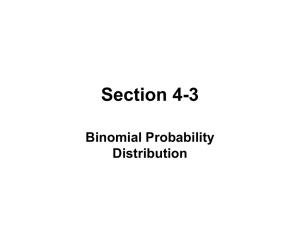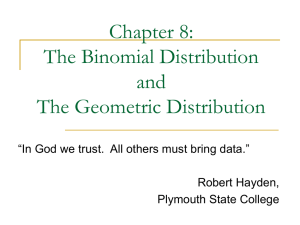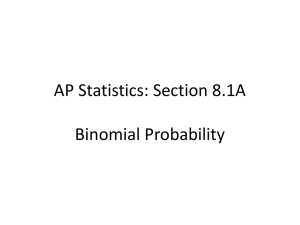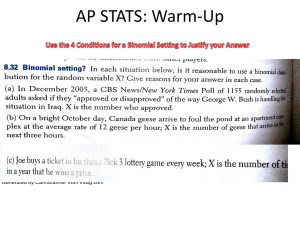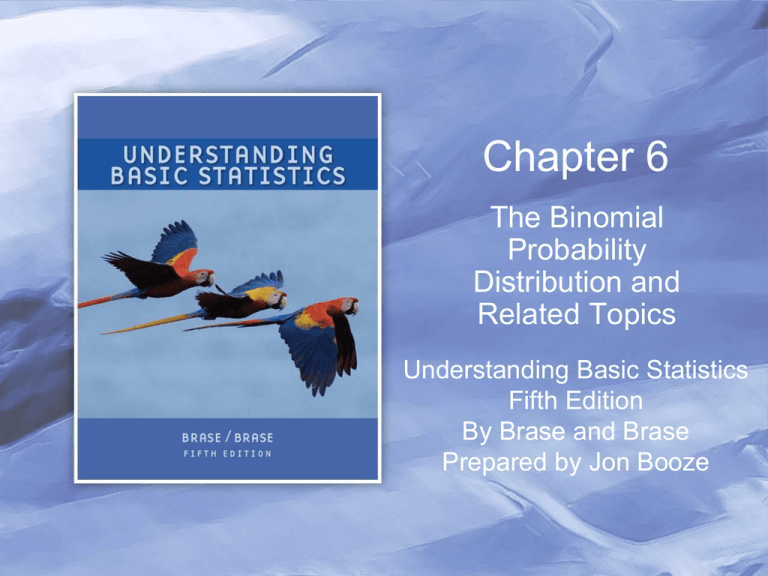
Chapter 6
The Binomial
Probability
Distribution and
Related Topics
Understanding Basic Statistics
Fifth Edition
By Brase and Brase
Prepared by Jon Booze
Statistical Experiments and
Random Variables
• Statistical Experiments – any process by which
measurements are obtained.
• A quantitative variable, x, is a random variable if
its value is determined by the outcome of a
random experiment.
• Random variables can be discrete or
continuous.
Copyright © Cengage Learning. All rights reserved.
6|2
Random Variables and
Their Probability Distributions
• Discrete random variables – can take on only
a countable or finite number of values.
• Continuous random variables – can take on
countless values in an interval on the real
line
• Probability distributions of random variables
– An assignment of probabilities to the
specific values or a range of values for a
random variable.
Copyright © Cengage Learning. All rights reserved.
6|3
Random Variables and
Their Probability Distributions
Which measurement involves a discrete
random variable?
a). Determine the mass of a randomly-selected
penny
b). Assess customer satisfaction rated from 1
(completely satisfied) to 5 (completely
dissatisfied).
c). Find the rate of occurrence of a genetic
disorder in a given sample of persons.
d). Measure the percentage of light bulbs with
lifetimes less than 400 hours.
Copyright © Cengage Learning. All rights reserved.
6|4
Random Variables and
Their Probability Distributions
Which measurement involves a discrete
random variable?
a). Determine the mass of a randomly-selected
penny
b). Assess customer satisfaction rated from 1
(completely satisfied) to 5 (completely
dissatisfied).
c). Find the rate of occurrence of a genetic
disorder in a given sample of persons.
d). Measure the percentage of light bulbs with
lifetimes less than 400 hours.
Copyright © Cengage Learning. All rights reserved.
6|5
Discrete Probability Distributions
1) Each value of the random variable has an
assigned probability.
2) The sum of all the assigned probabilities must
equal 1.
Copyright © Cengage Learning. All rights reserved.
6|6
Probability Distribution Features
• Since a probability distribution can be
thought of as a relative-frequency distribution
for a very large n, we can find the mean and
the standard deviation.
• When viewing the distribution in terms of the
population, use µ for the mean and σ for the
standard deviation.
Copyright © Cengage Learning. All rights reserved.
6|7
Means and Standard Deviations for
Discrete Probability Distributions
Copyright © Cengage Learning. All rights reserved.
6|8
Binomial Experiments
1) There are a fixed number of trials. This is
denoted by n.
2) The n trials are independent and repeated
under identical conditions.
3) Each trial has two outcomes:
S = success
Copyright © Cengage Learning. All rights reserved.
F = failure
6|9
Binomial Experiments
Which of the following does not involve binomial trials?
a). A recyclable item is placed into a bin meant for paper,
plastic, or glass.
b). A randomly-selected student passes a statistics course.
c). A electronic power supply is rejected if it delivers less
than 300 milliamps of current.
d). A given concept is classified as “traditional” or “modern”.
Copyright © Cengage Learning. All rights reserved.
6 | 10
Binomial Experiments
Which of the following does not involve binomial trials?
a). A recyclable item is placed into a bin meant for paper,
plastic, or glass.
b). A randomly-selected student passes a statistics course.
c). A electronic power supply is rejected if it delivers less
than 300 milliamps of current.
d). A given concept is classified as “traditional” or “modern”.
Copyright © Cengage Learning. All rights reserved.
6 | 11
Binomial Experiments
4) For each trial, the probability of success, p,
remains the same. Thus, the probability of
failure is 1 – p = q.
5) The central problem is to determine the
probability of r successes out of n trials.
Copyright © Cengage Learning. All rights reserved.
6 | 12
Determining Binomial Probabilities
1) Use the Binomial Probability Formula.
2) Use Table 2 of the appendix.
3) Use technology.
Copyright © Cengage Learning. All rights reserved.
6 | 13
Binomial Probability Formula
Copyright © Cengage Learning. All rights reserved.
6 | 14
Binomial Probability Formula
Find the probability of observing 6 successes in 10
trials if the probability of success is p = 0.4.
a). 0.111
b). 0.251
Copyright © Cengage Learning. All rights reserved.
c). 0.0002
d). 0.022
6 | 15
Binomial Probability Formula
Find the probability of observing 6 successes in 10
trials if the probability of success is p = 0.4.
a). 0.111
b). 0.251
Copyright © Cengage Learning. All rights reserved.
c). 0.0002
d). 0.022
6 | 16
Using the Binomial Table
1) Locate the number of trials, n.
2) Locate the number of successes, r.
3) Follow that row to the right to the corresponding
p column.
Copyright © Cengage Learning. All rights reserved.
6 | 17
Use Table 2 in the Appendix to find the probability of
observing 3 successes in 5 trials if p = 0.7.
a). 0.168
b). 0.343
Copyright © Cengage Learning. All rights reserved.
c). 0.264
d). 0.309
6 | 18
Use Table 2 in the appendix to find the probability of
observing 3 successes in 5 trials if p = 0.7.
a). 0.168
b). 0.343
Copyright © Cengage Learning. All rights reserved.
c). 0.264
d). 0.309
6 | 19
Binomial Probabilities
• At times, we will need to calculate other
probabilities:
• P(r < k)
• P(r ≤ k)
• P(r > k)
• P(r ≥ k)
where k is a specified value less than or
equal to the number of trials, n.
Copyright © Cengage Learning. All rights reserved.
6 | 20
Graphing a Binomial Distribution
Copyright © Cengage Learning. All rights reserved.
6 | 21
Mean and Standard Deviation of a
Binomial Distribution
np
npq
Copyright © Cengage Learning. All rights reserved.
6 | 22
Mean and Standard Deviation of a
Binomial Distribution
np
npq
Calculate the standard deviation of a binomial population
with n = 100 and p = 0.3.
a). 21
b).9
Copyright © Cengage Learning. All rights reserved.
c). 4.5825
d). 4.41
6 | 23
Mean and Standard Deviation of a
Binomial Distribution
np
npq
Calculate the standard deviation of a binomial population
with n = 100 and p = 0.3.
a). 21
b).9
Copyright © Cengage Learning. All rights reserved.
c). 4.5826
d). 4.41
6 | 24
Critical Thinking
• Unusual values – For a binomial distribution, it is
unusual for the number of successes r to be
more than 2.5 standard deviations from the
mean.
– This can be used as an indicator to
determine whether a specified number of r out of
n trials in a binomial experiment is unusual.
Copyright © Cengage Learning. All rights reserved.
6 | 25
Critical Thinking
• Unusual values – For a binomial distribution, it is
unusual for the number of successes r to be
more than 2.5 standard deviations from the
mean.
A particular binomial experiment has a mean of 14
and a standard deviation of 2. Which of the
following is not an unusual number of successes?
a). 16
c). 10
b).17
d). None of these are unusual.
Copyright © Cengage Learning. All rights reserved.
6 | 26
Critical Thinking
• Unusual values – For a binomial distribution, it is
unusual for the number of successes r to be
more than 2.5 standard deviations from the
mean.
A particular binomial experiment has a mean of 14
and a standard deviation of 2. Which of the
following is not an unusual number of successes?
a). 16
c). 10
b).17
d). None of these are unusual.
Copyright © Cengage Learning. All rights reserved.
6 | 27






